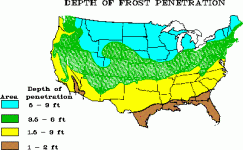NoTrespassing
Veteran Member
This info comes from a very nice pole building book I have. It has tons of info in it and I refer to it along with my framing book when I build.
<font color="red">
Contrary to popular thought, placing a concrete pad under the pole is not the most effective way to increase its bearing strength. According to pole engineers, a necklace of concrete poured around the pole increases its bearing strength considerably more. This is because the majority of the vertical load is transmitted to the soil by skin friction with the pole. Thus, increasing the surface area contact with a concrete necklace improves both the pole's vertical and lateral loadbearing ability.
For poles in average to good soils at the proper embedment depth, a 12inch concrete necklace poured below the frost line should be used. Lag screws should be embedded 6" from the bottom of the pole to help tie the pole and concrete necklace together.
After the concrete necklaces have been poured and allowed to set up for several hours, backfill with sand or crushed stone.
For poles in below average soils or poles that are at less than ideal embedment depth, a full necklace of and earth/cement mixture can increase the bearing capacity of the pole. Soil should be screened at 1 inch to remove large rocks and mixed 5 parts soil to 1 part concrete. This mixture is almost as strong as concrete for the purposes of a necklace and is considerably cheaper. Fill the entire hole up to within several inches of the surface with this mixture, using lag screws along the pole to secure it to the necklace.
</font>
Keep in mind, the above is for MAXIMUM RIGIDITY. Many of the buildings in this book support an entire 2 story+ house on poles. Just thought you might be interested in it.
Kevin
<font color="red">
Contrary to popular thought, placing a concrete pad under the pole is not the most effective way to increase its bearing strength. According to pole engineers, a necklace of concrete poured around the pole increases its bearing strength considerably more. This is because the majority of the vertical load is transmitted to the soil by skin friction with the pole. Thus, increasing the surface area contact with a concrete necklace improves both the pole's vertical and lateral loadbearing ability.
For poles in average to good soils at the proper embedment depth, a 12inch concrete necklace poured below the frost line should be used. Lag screws should be embedded 6" from the bottom of the pole to help tie the pole and concrete necklace together.
After the concrete necklaces have been poured and allowed to set up for several hours, backfill with sand or crushed stone.
For poles in below average soils or poles that are at less than ideal embedment depth, a full necklace of and earth/cement mixture can increase the bearing capacity of the pole. Soil should be screened at 1 inch to remove large rocks and mixed 5 parts soil to 1 part concrete. This mixture is almost as strong as concrete for the purposes of a necklace and is considerably cheaper. Fill the entire hole up to within several inches of the surface with this mixture, using lag screws along the pole to secure it to the necklace.
</font>
Keep in mind, the above is for MAXIMUM RIGIDITY. Many of the buildings in this book support an entire 2 story+ house on poles. Just thought you might be interested in it.
Kevin


